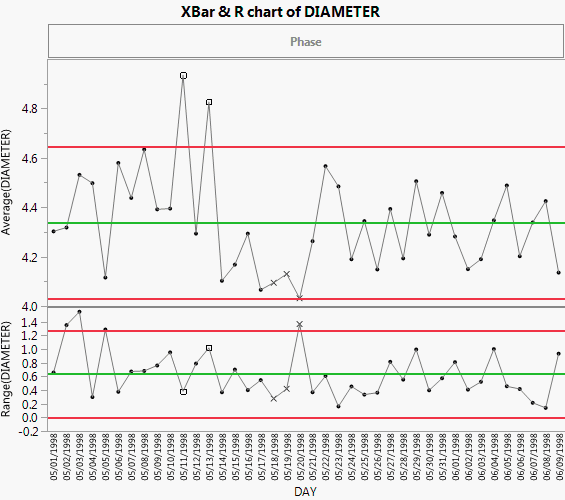

The purpose is to look at all of these values together to provide a complete picture of what’s happening. And like the X Bar and R Chart (you guessed it!), the Mean, UCL, and LCL represent the average of the standard deviations (also called S Bar) and the upper and lower control limits. This standard deviation of X is called S. But instead of using a range of values, each dot represents the standard deviation of the values in each subgroup. The S Chart is similar to an R Chart in that it measures the variation of the process. And, like the X Bar chart, the Mean, UCL, and LCL represent the average of the ranges (also called R Bar) and the upper and lower control limits. Each dot on the R Chart represents the range of values in each subgroup. The R Chart is used to visualize how widely the process varies over time. Any X Bar value that falls above the upper limit or below the lower limit could be considered “out of control”. Ideally, the subgroup averages, that is, the dots, should remain within those limits. The UCL and LCL are calculated with a standard formula. The red lines above and below are the Upper Control Limit (UCL) and Lower Control Limit (LCL). The gray center line is the Mean (or average) of those averages, also called the X Double-Bar.

Each one of the dots is an average of a certain number of samples in a subgroup. In an X bar chart, X is a sample value like cycle time or temperature. Basically, anything you want to control and make sure remains consistent can be monitored by a control chart. These types of charts can be used in a lot of places. S chart: This is best used for larger subgroup sizes, typically great than or equal to 11. Typically, the control charts are viewed in pairs, either an X-Bar with an R chart or an X-Bar with an S chart. We support 3 types of control charts: X-Bar, R, and S charts. We now support 3 different control charts, with greater detail provided in the next section. Knowing which chart will be most beneficial is going to be dependent on what is being produced at the plant.Ī few weeks ago, we added this capability to the Mingo platform. There are many types of control charts, each with a specific purpose. If a measurement is not within pre-set boundaries, there is a potential quality issue. These graphs are typically used in accordance with preventive maintenance, providing a critical measurement that will tell if the product is going to be of good quality or not. Is a particular process out of control or not? Within Mingo, manufacturers now have the ability to use control charts to understand process changes over time. You would use a statistical process control chart to monitor these metrics, and more. Maybe it’s a refrigerator and you need that temperature to stay within a particular range of control. A control chart will monitor cycle time for any fluctuations.Īnother example is temperature. Let’s say there is a process with a metric you want to track and ensure stays stable. The concept of Statistical Process Control (SPC) is a primary tool, prescribed by the methodologies of Six Sigma, to improve quality by reducing process variation.Ī control chart plots data over time to identify fluctuations in a process. In other words, SPC is a method of quality control that employs statistical methods to measure, monitor, and control a process.

Statistical Process Control:Statistical Process Control (SPC) is a statistical method to measure, monitor, and control a process. The control chart was invented by Walter Shewhart at Bell labs in 1920. The control chart is a graphical display of quality characteristics that have been measured or computed from a sample versus the sample number or time. What is a Control Chart?Ĭontrol chart: A control chart is one of the primary techniques of statistical process control (SPC). In this blog, we’ll talk about what a control chart actually is, how it’s used, and finally, walk you through how you’d use a control chart within Mingo. New Feature Alert:We recognize this importance control charts are now a feature within Mingo.

This is imperative in measuring, tracking, and maintaining quality. As a manufacturer, you need to know if your processes are stable and in control or unstable and out of control.


 0 kommentar(er)
0 kommentar(er)
